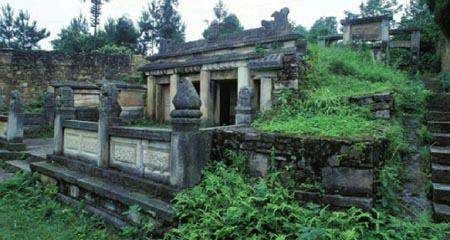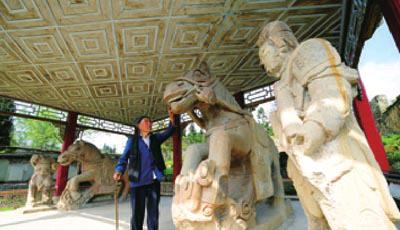Resurrected From the Past
2015-08-18ByJiJing
By+Ji+Jing
Three sites of the Tusi heritage—areas resided in by ethnic minorities in southwest and central China from the 13th century to the mid-20th century—were added to the list of the UNESCO World Heritage Sites in July, increasing the number of the countrys World Heritage Sites to 48, the second largest in the world following Italy.
The three sites are Laosicheng Fortress in central Chinas Hunan Province, Tangya Fortress in central Chinas Hubei Province and Hailongtun Fortress in southwest Chinas Guizhou Province.
Tusi refers to hereditary tribal leaders appointed by the Central Government to govern non-Han ethnic groups in the Yuan (1271-1368) and Ming (1368-1644) dynasties. In a broader sense, the term can be used to refer to the whole area where ethnic minorities used to reside under the governance of Tusi.
“The Tusi system was established in the Yuan Dynasty, matured in the Ming Dynasty and declined in the Qing Dynasty (1644-1911). It has had an influence on the politics, economy and culture of over 20 Chinese provinces where ethnic minorities live,” said Cheng Zhenming, a professor of history with Jishou University in Hunan.
“The Tusi system arose from ethnic minorities dynastic systems of government dating back to the third century B.C. Its purpose was to unify national administration, while allowing ethnic minorities to retain their customs and way of life,” says UNESCOs official website.
There are more than 3,000 Tusi remains across China; however, only around 100 are well preserved.
An obscure asset
Most of the Tusi sites in China are located on the southwestern Yunnan-Guizhou Plateau and Qinghai-Tibet Plateau and their surrounding mountainous regions. The Laosicheng and Tangya fortresses are seated between mountains and a river out of defense considerations.
A military castle created by ethnic minorities, Laosicheng Fortress resembles a chessboard, consisting of a residential area, an office area and a Tusi palace, with three streets running perpendicular to five others. All the streets are paved with cobblestones, which are arranged into geometrical patterns such as triangles and diamonds. These patterns are representative of the Tujia minoritys culture. Tujia is a minority ethnic group which resides mostly in mountainous regions in southwest China. It has a population of 8.35 million, ranking seventh among the 55 recognized ethnic minority groups in China, according to a 2010 census.
“A Tusi-headed community used to uphold a strict hierarchical order, which was exemplified by the roofs and pillars of residences. Only the roof of Tusi could be built with tiles. Lower-ranking officials could only use barks or thatches to cover their houses, but they were allowed to have pillars. Ordinary people, however, were disallowed to use pillars and could only build cottage-like homes with barks and thatches,” said Cheng, who specializes in the research of the Tusi system.
Tangya Fortress, the construction of which began in 1346, imitates the architectural style of the capital cities of the Han people, Chinas majority ethnic group. It is therefore known as the Tusi Forbidden City among locals. Zhang Zhongpei, former President of the Palace Museum in Beijing, hailed it as a “miniature of the Palace Museum” for its symmetrical layout and well-planned roads and yards.
The Tusi system played a crucial role in governing ethnic minorities in history. “The system provided a guarantee for social stability and is still informative for todays social governance,” said Zhang Guoxiong, a professor of Wuyi University in Jiangmen, south Chinas Guangdong Province.
Despite their historical importance, Tusi sites are little known among the average Chinese, and research in this regard is in a nascent stage.
“For a long time, few people knew about Tusi culture, except archaeologists. Now, the successful listing of the Tusi sites as World Heritage Sites has made their stories better known and will give a boost to Tusi research,”said Liu Qingzhu, a researcher with the Institute of Archaeology at the Chinese Academy of Social Sciences.
In order to promote the study and research of Tusi history and culture, Jishou University established a Tusi history and culture research center in November 2004 with Cheng as the director.
“Tusi research has been conducted for over 100 years in China; however, very few scholars are involved,” said Cheng, expressing his concern that few young people are willing to take the torch.
A joint effort
The joint bid for world heritage status by the three provinces is a strategy often adopted in world heritage applications in recent years.
According to UNESCO regulations, each country is allowed to apply for world heritage status for a maximum of one kind of site every year.
Among the three sites, Laosicheng Fortress was the first to prepare for the application. “If only Hunan is given permission to bid for the status and succeeds, the other two sites will have virtually no chance to apply any longer,”said Emma Chen Hoefler, Chair of the China Section of IOV, a worldwide organization dedicated to promoting folk art.
In early 2013, the State Administration of Cultural Heritage packaged the three aforementioned Tusi sites as one candidate for the 2015 world heritage status. Such a practice has enabled Tusi sites in multiple locations to bid for the World Heritage Sites status using only one attempt, Chen added. In less than three years, the three provinces completed a series of preparations.
China has had several successful experiences involving package application. Last year, it filed an application for the Silk Road, an ancient trade route between Asia and Europe, to become a World Cultural Heritage Site along with Central Asian countries Kazakhstan and Kyrgyzstan, and succeeded. The bid was filed in the name of Kyrgyzstan. In the same year, the Grand Canal, the longest man-made waterway in the world, constructed in the 13th century to transport grain from south China to north China, made it into the World Heritage List with a bid by eight provinces and cities running through the canal.
A site which enters the World Heritage List will undoubtedly bring huge benefits to the local economy. “Many places are eager to transform World Heritage Sites into tourist destinations, causing damage to the precious history there,”said Hoefler.
However, Tong Mingkang, deputy head of the State Administration of Cultural Heritage, has promised to strengthen the protection of the Tusi sites in keeping with the World Heritage Convention.
